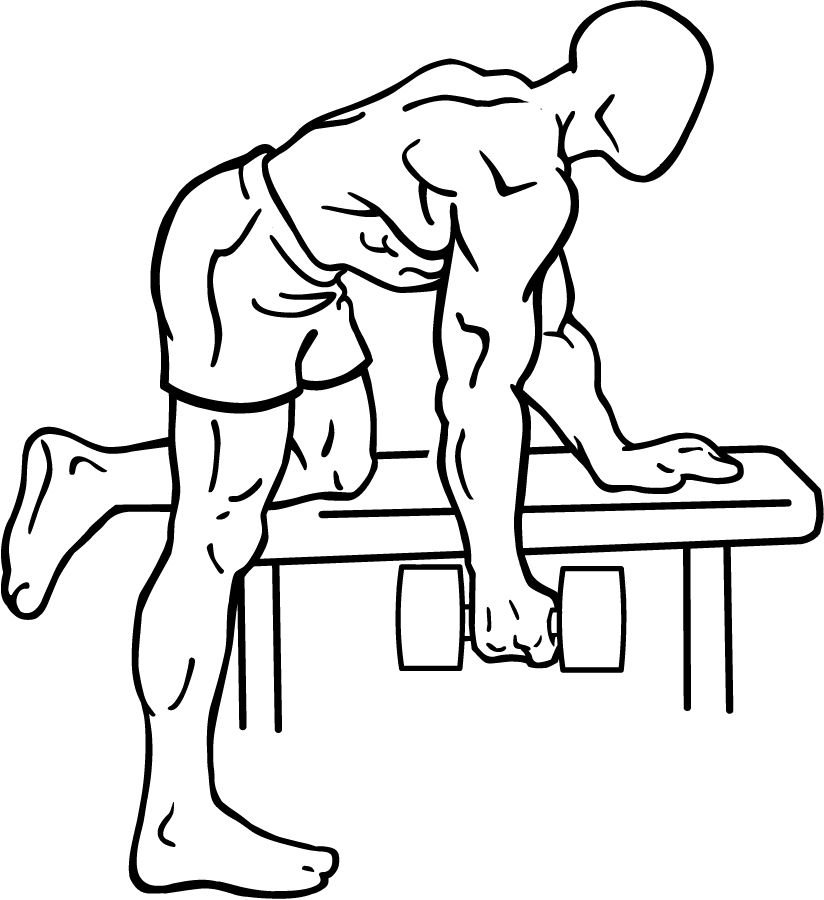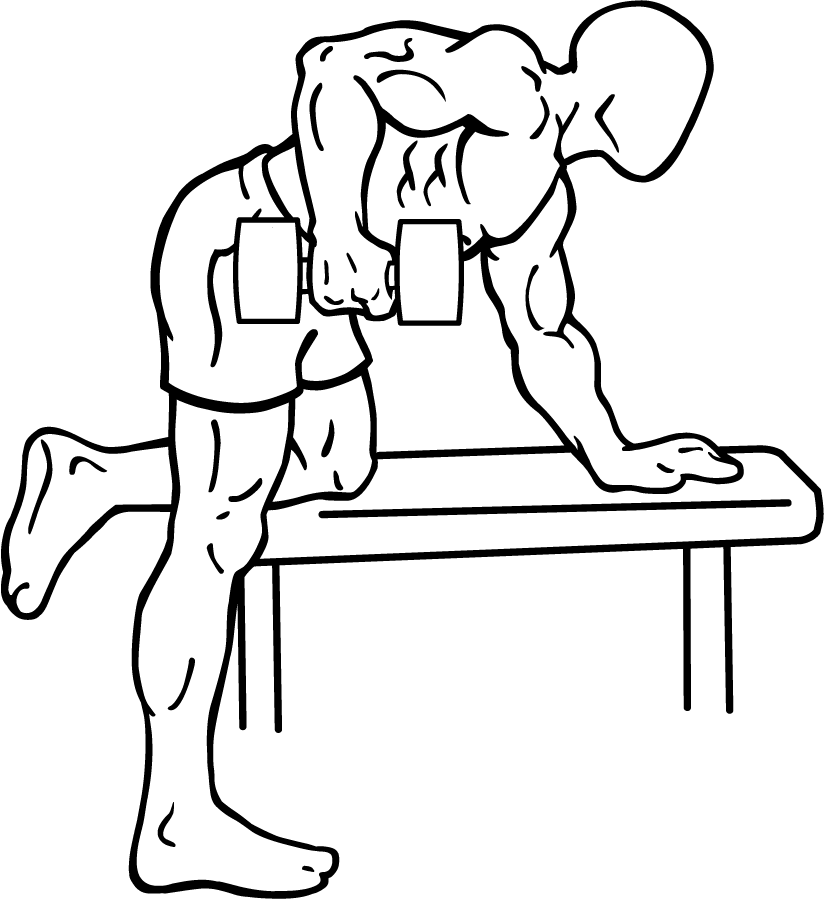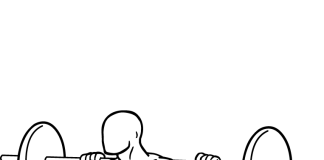Last Updated on September 30, 2014
The Rear Deltoid Row with Dumbbell is a powerhouse exercise that primarily targets the rear deltoids (back of the shoulders), biceps, and trapezius muscles. This exercise is not only excellent for building upper-body strength but also essential for achieving balanced shoulder development. Strengthening the rear deltoids is crucial because it improves shoulder stability, posture, and gives your upper body a more sculpted look. With proper form, this exercise can help you develop strong, well-defined shoulders and a stable upper back, which is essential for many daily movements and sports activities.
In this comprehensive guide, we’ll dive deep into the benefits, proper technique, tips for maintaining form, common mistakes to avoid, variations to challenge your muscles, and how to incorporate the Rear Deltoid Row into your workout routine.
Benefits of the Rear Deltoid Row with Dumbbell
- Strengthens the Rear Shoulders: This exercise targets the rear deltoid muscles, which play a significant role in shoulder stability and balance.
- Improves Posture: Many people struggle with rounded shoulders due to desk work or other daily habits. The Rear Deltoid Row works against this by strengthening the muscles that pull the shoulders back, improving posture.
- Enhances Upper Back Stability: The trapezius and upper back muscles are engaged throughout the movement, promoting stability and strength in the upper back.
- Increases Arm Strength: Since the biceps are also activated during this exercise, you’ll build stronger, more defined arms.
- Supports Functional Movements: By mimicking the pulling movements we use in everyday life, this exercise helps build functional strength.
Muscles Worked
The Rear Deltoid Row with Dumbbell targets several muscles:
- Rear Deltoids: Located at the back of the shoulders, these muscles are responsible for moving the arms backward and stabilizing the shoulder joints.
- Trapezius: The traps span the neck, shoulders, and upper back. They’re engaged in this exercise to stabilize and pull the shoulders back.
- Rhomboids: Situated between the shoulder blades, rhomboids help with scapular retraction and support a strong back.
- Biceps: The biceps in the upper arm assist with pulling movements.
- Latissimus Dorsi: Also known as the lats, these muscles in the upper back help with stabilization.
Step-by-Step Guide to Performing the Rear Deltoid Row with Dumbbell
Step 1: Set Up Your Position
- Find a Stable Bench: Place a flat bench in an area with enough space around you to ensure a full range of motion.
- Choose an Appropriate Dumbbell: Start with a weight that feels challenging but manageable, especially if you’re new to the exercise. You can always increase the weight as you become more comfortable with the movement.
Step 2: Position Your Body
- Place Your Left Knee and Left Hand on the Bench: With your left hand positioned directly under your shoulder and your left knee stable on the bench, you’ll create a strong support base.
- Keep Your Right Foot on the Floor: Place your right foot flat on the ground to provide balance and stability.
- Maintain a Flat Back: Your back should be straight and slightly tilted forward at a 45-degree angle. Avoid arching or rounding your back to protect your spine.
Step 3: Grip the Dumbbell
- Reach for the Dumbbell with Your Right Hand: Keeping your back flat, reach down and grab the dumbbell with your right hand. Your grip should be firm but relaxed.
- Arm Extended: Start with your right arm fully extended down towards the floor, holding the dumbbell comfortably in your hand.
Step 4: Begin the Rowing Motion
- Initiate the Movement from Your Shoulder and Elbow: Start by pulling your elbow up and back, keeping it close to your side. Focus on bringing the dumbbell as close to your chest as you can without twisting your torso.
- Squeeze Your Rear Deltoids and Trapezius: As you lift, focus on squeezing your rear deltoid and upper back muscles to engage them fully.
- Keep Your Back Flat: Avoid rounding your back or shrugging your shoulders. Your torso should stay stable and straight throughout the movement.
Step 5: Hold the Position at the Top
- Pause and Squeeze: When your elbow is at its highest point, close to your body, hold the position for a brief moment (1-2 seconds) to maximize muscle engagement.
- Feel the Contraction: Focus on feeling the squeeze in your rear deltoids and upper back before lowering the dumbbell.
Step 6: Lower the Dumbbell
- Controlled Descent: Slowly lower the dumbbell back to the starting position. This eccentric (lowering) phase is just as important as the lift, as it continues to work the muscles and improve strength.
- Repeat for Desired Repetitions: Aim for 10-15 repetitions on one arm before switching to the other side.
Step 7: Switch Sides
- Opposite Positioning: To switch sides, place your right knee and right hand on the bench, and put your left foot flat on the ground.
- Repeat the Movement: Follow the same steps, performing the rows with your left arm.
Tips for Proper Form
- Avoid Twisting the Torso: Keep your torso stable throughout the exercise. Twisting reduces tension on the target muscles and can lead to improper form.
- Keep Your Core Engaged: Maintain core stability by keeping your abs tight, which helps support your lower back and improves balance.
- Focus on the Mind-Muscle Connection: Visualize your rear deltoids and upper back muscles contracting during each rep to increase muscle engagement.
- Don’t Rush the Movement: Performing the exercise too quickly reduces its effectiveness. Move in a slow, controlled manner to maximize muscle activation.
- Use a Mirror (if possible): To ensure your back stays flat and your form is correct, perform the exercise in front of a mirror.
Common Mistakes and How to Fix Them
- Rounding the Back: Rounding your back can lead to poor posture and increase the risk of injury. Focus on keeping your back flat and your core engaged.
- Using Too Much Weight: If you can’t control the dumbbell, you may be lifting too much weight. Start with a lighter weight and increase gradually.
- Shrugging the Shoulder: Avoid letting your shoulder shrug upward during the row. Keep it stable to engage the target muscles more effectively.
- Lifting with the Arm Alone: Engage your rear deltoid and upper back rather than relying on your arm strength alone. This will maximize the benefits for the target muscles.
- Quick Movements: Going too fast can reduce the tension on your muscles. Focus on slow, controlled motions to get the most out of each rep.
Variations of the Rear Deltoid Row
- Standing Rear Deltoid Row with Dumbbell: Stand with a slight forward lean, holding a dumbbell in each hand. Perform the row in a similar manner, pulling the weights toward your chest. This variation challenges your core and balance.
- Incline Bench Rear Deltoid Row: Lie face down on an incline bench, holding dumbbells in each hand. This position provides extra support for your torso, allowing you to focus on your shoulders and upper back.
- Cable Rear Deltoid Row: Use a cable machine with a low pulley setting. Cables provide constant tension, which can enhance muscle activation.
- Single-Arm Row on a Stability Ball: Instead of a bench, rest one knee and hand on a stability ball. This increases the difficulty by challenging your balance and core stability.
- Two-Arm Dumbbell Rear Deltoid Row: Perform the movement with both arms simultaneously. This version is ideal for those looking to save time and add intensity.
How to Incorporate Rear Deltoid Rows into Your Workout
- During Shoulder Workouts: Include this exercise in a shoulder-focused routine to fully develop the deltoids. Pair it with other shoulder exercises like lateral raises and overhead presses.
- In a Pull Day Routine: Since it’s a pulling exercise, add it to your pull day alongside exercises like lat pulldowns and bicep curls.
- Within a Full-Body Circuit: Include it as one of the upper body movements in a full-body workout circuit for balanced strength.
- For Posture Training: This exercise is excellent for anyone looking to improve their posture. Performing it regularly helps combat rounded shoulders.
Sample Workout Routines Featuring Rear Deltoid Rows
1. Upper Body Strength Routine
- Bench Press: 3 sets of 8 reps
- Pull-Ups: 3 sets of 10 reps
- Rear Deltoid Row with Dumbbell: 3 sets of 12 reps each side
- Overhead Press: 3 sets of 10 reps
- Tricep Extensions: 3 sets of 12 reps
2. Full-Body Circuit
- Squats: 3 sets of 15 reps
- Push-Ups: 3 sets of 12 reps
- Rear Deltoid Row with Dumbbell: 3 sets of 12 reps each side
- Lat Pulldown: 3 sets of 10 reps
- Plank: Hold for 30-45 seconds
Advanced Techniques for the Rear Deltoid Row
- Drop Sets: After reaching failure, immediately drop to a lighter weight and continue the exercise until failure. This technique helps to exhaust the muscles for maximum gains.
- Isometric Hold: At the top of the row, hold the position for 3-5 seconds to intensify the muscle contraction.
- Slow Negatives: Lower the dumbbell slowly (for about 3-5 seconds) to maximize the eccentric phase of the exercise, which promotes muscle growth.
- Supersets: Pair the Rear Deltoid Row with an opposite muscle group exercise, like push-ups, to work the upper body more thoroughly.
- Tempo Training: Perform the lift with a controlled tempo, such as 2 seconds up, 2 seconds hold, and 3 seconds down, to keep the muscles under tension for longer.
Frequently Asked Questions
How Heavy Should the Dumbbell Be?
Start with a weight that allows you to perform the exercise with good form. If you’re new to strength training, begin with a lighter weight (5-10 pounds) and gradually increase as you feel comfortable.
How Many Reps and Sets Should I Do?
For strength and muscle growth, aim for 3-4 sets of 10-15 reps. If you’re focusing on endurance, consider 15-20 reps with a lighter weight.
Can I Do This Exercise Every Day?
It’s generally recommended to allow 48 hours of rest between workouts targeting the same muscle group. This allows for adequate recovery and muscle growth.
How Can I Avoid Shoulder Pain During This Exercise?
Make sure to maintain proper form and avoid shrugging or rounding your shoulders. If you feel pain, consider reducing the weight or focusing on a variation that offers more stability, like the incline bench variation.
Final Thoughts
The Rear Deltoid Row with Dumbbell is a versatile and effective exercise for building upper body strength, improving posture, and enhancing shoulder stability. By following the proper technique, avoiding common mistakes, and implementing variations, you can make this exercise a key part of your fitness routine. Whether you’re looking to improve aesthetics, support shoulder health, or build functional strength, consistent practice of the Rear Deltoid Row can bring impressive benefits to your upper body development.








